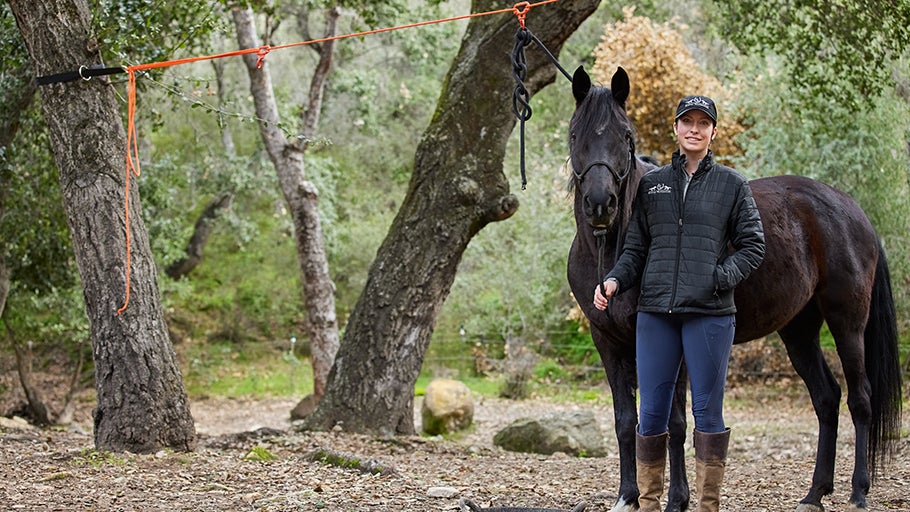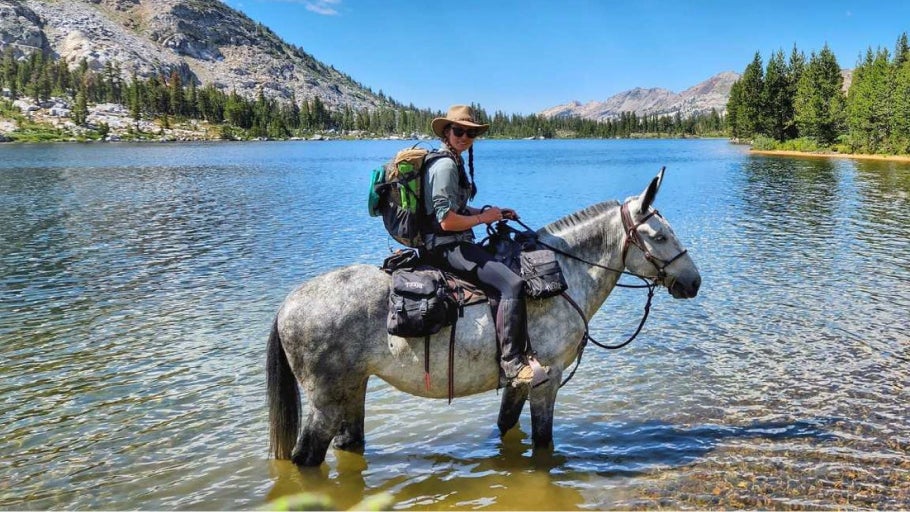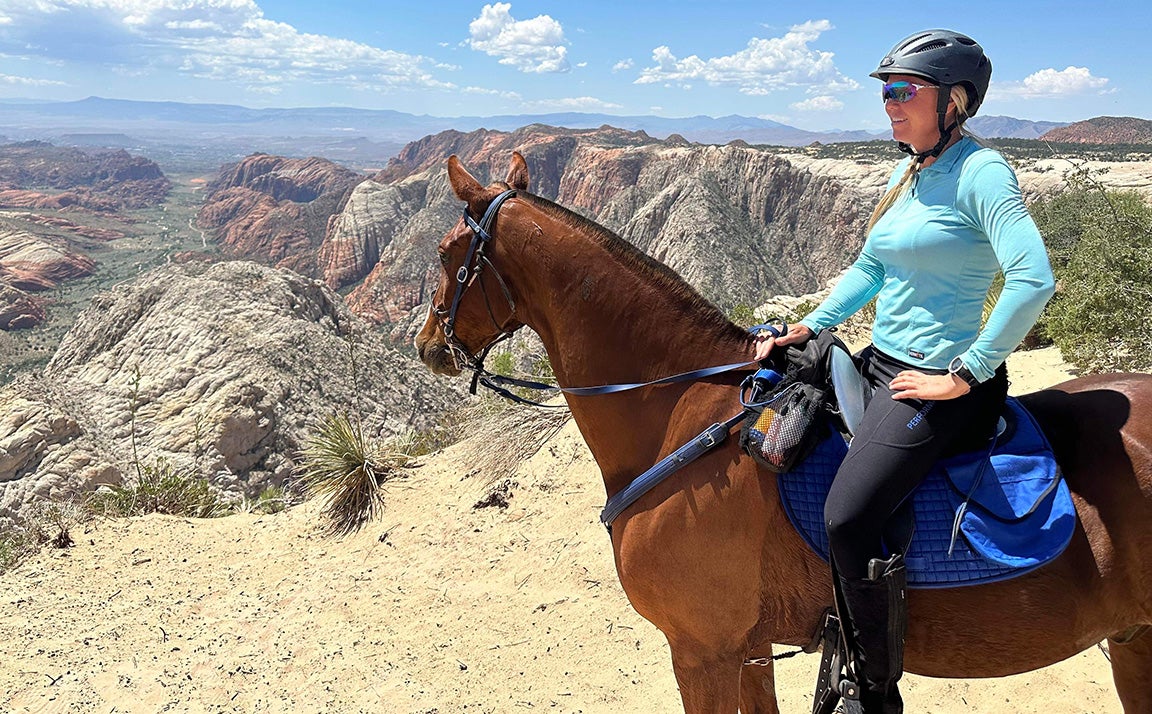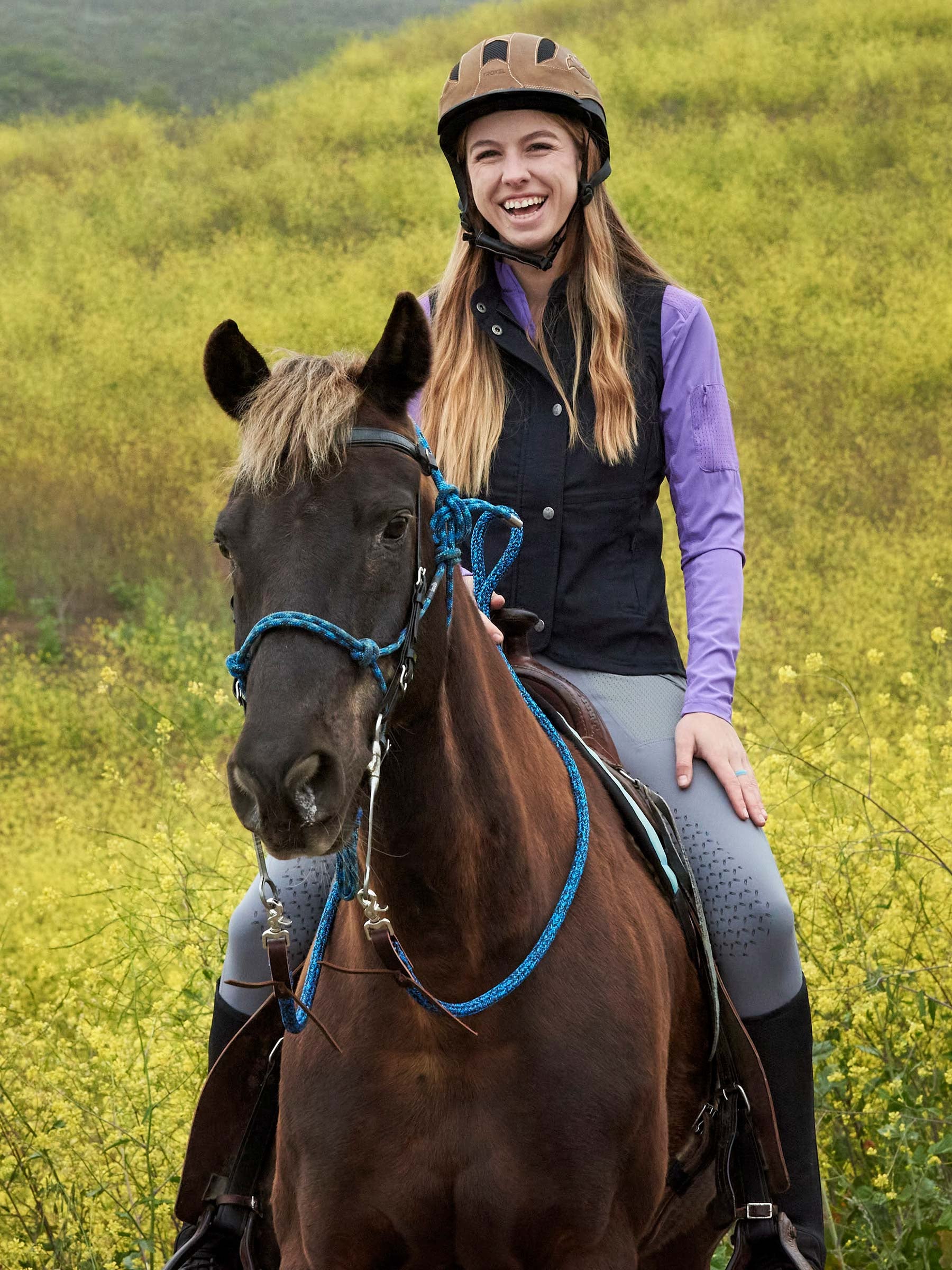
What to Pack in Horseback Riding Saddlebags
Horseback riding saddlebags are a wonderful tool for riders who want to bring extra gear, first-aid items, or food and water with them while they're training, competing, or simply enjoying nature alongside their equine partner. Secured to the saddle, saddlebags are built to carry everything the horse and rider might need. The saddlebag is a great piece of gear that many trail, endurance, and backcountry riders choose to tack up with.
In this guide, our crew of equine experts will address the types of saddlebags and go over lists of essential and emergency items you should consider packing for day use and multi-day use. We will also answer a few frequently asked questions about saddlebags, so you can feel better prepared for both your purchase and the adventure ahead!
Types of Saddlebags & Considerations
You should consider the rigging attachment points on the saddle you ride in, as well as what kind of riding you'll be doing. Saddlebags are broken down by whether they attach to the pommel (front) or cantle (back), then further broken down by features like insulation, buckles, compartment space, and more. For example, a backcountry rider needs more saddlebag space than a casual trail rider.
With any saddlebag you're interested in, be sure to look at how it's supposed to attach to a saddle; it's important for the saddlebag to be as secure as possible to limit the possibility of any bouncing that might irritate you and your horse. Think about it: a saddle with no D-rings is significantly harder (if not impossible) to attach a saddlebag to. Some riders just want to bring water along with them, while others need something extra outside of a saddlebag. We have the products to meet your needs in these areas as well!
Pommel Saddlebags
Pommel saddlebags attach to the front of the saddle for easy access to the items you use most often. Designed to go over or clip around the saddle horn, this type of saddlebag is great for riders looking for convenience. With the saddlebag compartments directly below you in the saddle, you can see everything you're grabbing while keeping a better eye on the trail ahead.
Cantle Saddlebags
Cantle saddlebags attach to the back of the saddle to typically carry bulkier items or things you need when dismounted, such as your rain jacket or lunch. This saddlebag type follows the contour of the cantle and is typically secured under the fender or saddle flap to the girth/cinch rigging. Cantle saddlebags tend to have more room, so they're great for any cumbersome items that might get in your way at the front of your saddle.
Water Bottle Holders
If your saddlebag doesn't have water bottle holders or you don't ride with a water bladder on your back, then you need a water bottle holder to stay hydrated on the trail. Dehydration can be dangerous, so it's especially important to keep drinking if it's hot out! Always bring more water than you think you need.
Other Saddlebag Accessories
When you need something specialized, saddlebag accessories that are gear-specific come in handy. Whether you just want to securely carry your phone on your person or need a scabbard for your hand saw to cut down branches, an accessory might be just what you need for a minimalist or maximalist look!
Building Your Saddlebag Essentials & Emergency Kit
When you're out on the trail by yourself or with other riders, something unexpected could happen at any point of the ride. If you do ride by yourself, it is wise to always notify someone of where you'll be riding and how long you'll be gone. Depending on the situation, something as simple as gauze can make a big difference in preventing an unfortunate injury from becoming even worse. It is highly advisable to bring along at least a few emergency items as a precaution during your trail rides.
Let's address the specifics of what emergency items you should consider carrying in your saddlebags to help any horse or human issues that may come up. We'll start by breaking down suggestions for day-long horseback rides, then you can further build out your emergency kit as necessary with additional items if you'll be doing dangerous or multi-day rides. You will need to consider the weight your horse is carrying and pack your saddlebags evenly to ensure proper weight distribution.
Please be aware that these are suggestions; use your discretion to determine what is most important to you to keep in your saddlebags and on your person. It's recommended to pack supplies with multiple uses that are lifesaving, practical, and portable.
Essential & Emergency Items for Day-Long Rides
Trail riders that are heading out for just the day do not necessarily need an extensive list of emergency items unless they want to be extra safe and prepared (or the riding will be treacherous). If you participate in the discipline of endurance, then your saddlebags will likely look the same on competition day as they do on your training rides. Endurance is a highly demanding sport, and your saddlebags might vary slightly depending on you and your horse's specific needs—such as the amount of electrolytes you need to bring along. Be sure to know the ins and outs of your saddlebags, then add and remove things as necessary!
For the Horse
- Hoof Pick: Arguably the best thing you can pack for your horse, a hoof pick is essential to have on hand in case a rock or other debris gets stuck in your horse's hoof. A hoof pick can help prevent a stone bruise or abscess from happening if you are proactive with keeping one on hand and checking your horse's hooves.
- Topical Wound Care: Whether in the form of salve, powder, or spray, a topical wound care product is imperative to have on hand for any scrapes, cuts, or wounds that are in need of a clean, moist environment to promote healing.
- Vet Wrap & Gauze: Both vet wrap and gauze are really handy to have on hand for wrapping wounds on horses and humans!
- Electrolytes: Especially if you're an endurance rider, electrolytes are imperative to have on hand for your horse's hydration and cellular health. Typically brought along in the form of pastes or syringes of hand-made solutions, electrolytes are great to have on hand when your horse needs its mineral levels replenished. Check out our electrolyte supplement guide for more information.
- Halter & Lead: An extra halter and lead rope are great to pack in case your headstall breaks beyond repair, you stumble upon a loose horse, or you need to tie your horse for an extended time.
- Extra Leather Strings: Extra leather strings in varying lengths are great for repairing broken tack. We like the variety offered in the Weaver Leather Laces Assortment, or the convenient 12-pack of Berlin Custom Leather Latigo Replacement Ties.
- Spare Hoof Boots: If your horse is shod with steel or composite horseshoes and pulls one on the trail, it's important to have an appropriately sized hoof boot (preferably a pair) on hand to give them the support they need until the shoe can be put back on. Learn more about the types of hoof boots and how to measure them in our hoof boot guide!
- I.C.E. Tag: I.C.E stands for "in case of emergency," so it's a no-brainer to have one or multiple of these emergency clips attached to your horse via the saddle, mane, or another location. In the event that your horse runs off without you and is later found by someone else, that person will know who the owner and vet are, and how to get ahold of them!
- Food and Water: Bring along high-calorie snacks that don't spoil quickly or make a mess in your saddlebags, such as jerky, nuts, and meal bars. Food with sugar and complex carbs are great as well. Also bring plenty of water! A good rule of thumb is to bring twice as much water as you think you need. Some riders choose to ride with a water bladder backpack versus packing water bottles in their saddlebags.
- Electrolytes: When you need an extra boost of hydration, human electrolytes can make a big difference in your health during your ride. Riders who are prone to getting dehydrated on the trail should drink electrolytes to prevent further dehydration.
- Multi-Tool or Knife: Most multi-tools have a knife built into them, but it's wise to also have a sharp pocket knife on hand for emergencies, like if your horse becomes tangled. Multi-tools address a variety of equestrian needs while out on the trail.
- Lip Balm: Lip balm is fantastic for dry lips suffering from the outside elements. A customer favorite and inexpensive option, our Riding Warehouse SPF15 Natural Lip Balm protects your lips from becoming chapped or sunburnt.
- Sunscreen: Hours upon hours in the sun means more UV exposure and a higher risk of sunburn, and sunscreen is an easy way to protect your delicate skin. Don't forget to reapply every few hours!
- Flashlight or Headlamp: If you're competing in an endurance ride through the early morning or night hours, or you're simply required to navigate trails in the dark, then a light source is a necessity! Headlamps are preferred because they can attach to your head or helmet for a consistent, hands-free path of light. At the very least, it's a good idea to have a flashlight in your saddlebag just in case. Always make sure the batteries have juice, because nobody wants to be stuck in the dark halfway through a ride!
- Gloves: Riding in a durable pair of gloves is handy for weather and sun protection, but we also suggest packing another set of gloves in your saddlebags. In case your riding gloves rip for any reason, or you need a thicker leather pair to move brush off of the trail, a spare set of gloves is important.
- Benadryl: You may not need it, but a fellow horseback rider might! Some allergic reactions can turn deadly depending on their severity, so it's good to have Benadryl on hand (especially for bee stings).
- Pain Reliever: If you take a bad fall or are experiencing pain in general, then a pain reliever like Advil or Ibuprofen will be your best friend. It can make a difference to start pain relief before, during, and after your ride depending on how much pain you're experiencing. A pal might need some relief too, so bring extra!
- Waterproof Riding Jacket: A waterproof riding jacket is fantastic to keep on hand in the event of sudden rain showers. If you simply need an additional layer to be warmer, then you'll also have one at the ready.
- Wound Ointment & Band-Aids: A topical antibiotic ointment and Band-Aids or other adhesive bandages will allow you to treat and protect any minor wounds you may incur on the trail.
- Toilet Paper, Tissue, or Wet Wipes: Whether you have a congested or bloody nose, or you're going to the bathroom off of the trail, these items help you feel cleaner on the trail. You can also use wet wipes to help clean debris from any cuts or scrapes you or your horse may incur. Bring along a plastic bag to act as a trash bag for used tissues or wipes. Regularly check your wet wipes to see if they've dried out.
Additional Essential & Emergency Items to Consider
The cool thing about packing your own saddlebags is you can bring specific items that are essential for you and the type of riding you do in your area. It's also wise to consider items that universally apply to every type of ride in your region; for example, the possibility of snakebites if there's a known snake population. Let us take a look at additional gear you should consider packing, especially if you participate in overnight or multi-day rides. For more information on prepping for backcountry riding, take a look at sponsored rider Gillian Larson's essential backcountry and camping gear!
For the Horse
- Betadine: For superficial lacerations, abrasions, and minor burns, Betadine is well known in the equestrian realm. If you can secure a smaller-sized bottle for your saddlebags, even better!
- Extra Reins: In case your reins break, you didn't bring an extra lead rope with you, or you need to make a tourniquet in an emergency situation, then a spare set of reins will be a huge help.
- Syringes/Tubing in Multiple Sizes: Especially if you're riding in areas where snake bites could happen, then tubing or syringe cases of multiple lengths will help maintain the horse's airways if they're swelling shut after a snake bite to the face.
- Eye Treatments: We love the Vetericyn Plus Antimicrobial Eye Care Kit that includes both an eye wash and ophthalmic gel!
- Hoof Nippers & Small Hoof Rasp: A pair of hoof nippers and small hoof rasp that can fit in a saddlebag will be helpful for removing any rough edges or minor hoof chips.
- Bug/Fly Spray: It's always wise to do a thorough fly spray treatment before you leave on your ride, but it's handy to keep a small fly treatment in your saddlebags if you or your horse are being bothered by flies. Our staff loves the Stop Bugg'n Organic All Natural Fly Repellent Stick!
- Bute & Banamine: Bute and Banamine are ideal for emergency situations!
- Highline/Picket Line System: If you're temporarily tying your horse up for a long lunch break or out in the backcountry, a picket line kit is convenient. Follow sponsored rider Gillian Larson's guide on how to set up a high line system!
For the Rider
- Duct Tape: Used for absolutely everything—duh!
- Fire Supplies: Waterproof matches, flint and steel, and fire starters.
- Emergency Blanket: An emergency blanket is compact, lightweight, and warm in case of an emergency.
- Water Purifier: Iodine tablets or another form of water purification for safe ingestion of natural water sources.
- Whistle: If you need assistance, a whistle can alert anyone nearby better than yelling, and it can help you save your breath.
- Zip Ties, Bailing Twine, or Parachute Cord: All of these can be used to fix tack or tie other equipment in a pinch.
- Wire Cutters: If you come across barbed wire and your horse becomes entangled in it, wire cutters are really handy to have as a safety precaution!
- Freeze-Dried Meals: These are lightweight and easy to mix with water for quick sustenance, especially if you're doing some backcountry camping.
- Hand Sanitizer: Sanitizer is good to have for general sanitary reasons, such as after you use the bathroom (off of the trail, of course).
- Medications: Ibuprofen, Keflex, bacitracin ointment, OcyContin, Ondansetron tablets, EpiPen (auto-injectors), antacid.
- Rain Gear: Having waterproof clothing will keep you warm and dry in the event of rain, heavy fog, or other inclement weather.
- Hand Saw: Folding hand saws are ideal for cutting down branches that might be obstructing your trail progression. The Cashel Trail Clearing Saw and Pruner Scabbard 20" is also great for safely bringing along your preferred pruner and saw when you know you're going to be riding in an area with a lot of brush.
Suggested Items to Carry on Your Person
- Cell Phone: Keeping your phone on your person ensures it is close by in case you come off of your horse and are separated. If you have service, you can use it to call for help.
- Pocket Knife: A pocket knife on your person, apart from a multi-tool or knife possibly already in your saddlebags, ensures you always have a basic survival aid.
- Prescription Medication: If you have prescription medication needs, it's better to have these on your person for obvious health reasons.
- Compass & Map or GPS: Having navigational tools on your person means you can find your way around, even if you get separated from your horse and the trail.
- Water Bladder Backpack: Some riders choose to keep a water bladder backpack on their person so they have a water source if they come off of their horse.
Frequently Asked Questions
How do I choose what to bring in my saddlebags?
When it comes to packing your saddlebags, consider what is helpful for every type of ride and what's applicable for the terrain, weather, etc. you will be riding in. Essentials like a first-aid kit are staples, while other gear items—such as an extra set of reins—might not be essential to you. Please use your discretion to think about what you would actually use on the trail, as well as what you might want in case of an emergency.
The items you pack should be multipurpose, lightweight, practical, and have the potential to save a life. There's the possibility of a serious problem or accident any time you get on horseback, so it's better to be prepared in order to relax and enjoy the ride with your horse. Cut down on bulk and weight wherever you can, then distribute your items evenly on both sides of your saddlebags.
Where should I keep my cell phone during trail rides?
It is highly recommended to keep your cell phone on your person during trail rides, endurance competitions, or backcountry camping, because you can quickly contact help in case of an emergency. For example, if you fall off of your horse and need help, get separated from your riding group, encounter a hazard on the trail and need to report the issue, or simply prefer having direct access to communication, then you'll be happy to have your cell phone on you. Always make sure your phone is fully charged before your ride, and avoid being distracted by it while you're out and about; it's better to stay aware of your horse and surroundings!
How do I tie saddlebags to my saddle?
Tying your saddlebags on will depend on the design of the bags and saddle you're using, as attaching them differs between designs. For example, a pommel saddlebag designed to slip over a western saddle horn does not make sense when you're trying to use it with an English-style saddle with no horn. First, consider the attachment points on your saddle and where the saddlebag straps would be most secure before you buy. If it's the Tucker Adventurer Saddlebags you're interested in, then check out the video below from sponsored rider Gillian Larson to learn how to rig them!
Closing Thoughts
It is entirely up to user discretion when it comes to determining what items to pack in your horseback riding saddlebags. Whether you lean toward minimalism with just the basics or want to be prepared for every possible emergency situation, a good place to start is with the saddlebags themselves. Invest in quality saddlebags that will be durable for the long haul so you can carry as many or as few items as you want! We hope you found this guide helpful, and we encourage you to reach out to us via phone at 1-800-620-9145 or via email at info@ridingwarehouse.com if you have any other questions or concerns. Happy packing!
Related Articles












